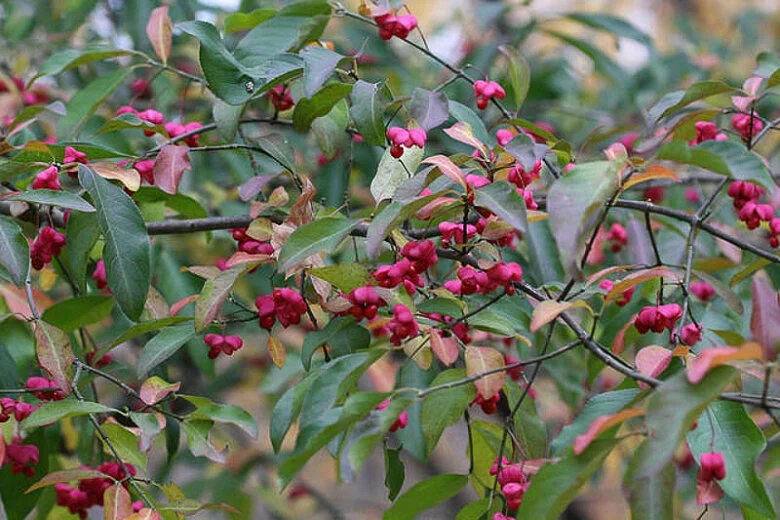Over the years, I have attempted to be increasingly mindful of adding plants to the garden that will provide winter interest. Fortunately, in this area we have abundant choices.
All in In the Garden
The Wahoo
Last Friday, the volunteer Friends of Little Crum Creek Park convened for work. Our goal was removing invasive plants such as Norway maple, Acer platanoides; Amur honeysuckle, Lonicera maackii; and the burning bush, Euonymus alatus. We were discussing some good native alternatives to these plants when I thought of a counterpart to the burning bush: Euonymus atropurpureus, the Eastern wahoo. Unlike burning bush, which has choked out most of the understory in parts of Eastern forests, this shrub is not invasive.
Getting Involved: A Pathway to Gardening
A couple weeks ago, several of us toured Little Crum Creek Park. A large portion of the tour focused on invasive plants and how they are impacting the natural areas of the park. As a gardener, I think it is valuable to have a working knowledge of invasive plants. With knowledge, our actions can help remedy their damage; conversely, in ignorance, we can inadvertently contribute to the problem.
Invasive Plants
A couple weeks ago, several of us toured Little Crum Creek Park. A large portion of the tour focused on invasive plants and how they are impacting the natural areas of the park. As a gardener, I think it is valuable to have a working knowledge of invasive plants. With knowledge, our actions can help remedy their damage; conversely, in ignorance, we can inadvertently contribute to the problem.
Garden Design 101
I recently ran into Swarthmore resident Ginny Scott at a Swarthmore Horticultural Society open house at my garden. She asked, “What general tips can you share for garden design, especially for the small gardens typical of this area?” It’s a great question. Her query made me think about my own evolution as a garden designer. I never attended any garden design classes, but perhaps something like Garden Design 101 would have been helpful.
Great Flowering Plants for the Fall
Today I thought I would walk around Swarthmore to see what interesting perennials are in flower this time of year in the town’s many great residential gardens. Most years, in the Delaware River Valley, we expect good flowering throughout October. Some years, flowering extends well into November.
My Best Fronds: Favorite Ferns for the Garden
A gardening friend said to me the other day, “I never met a fern I didn’t like.” I generally agree. While some ferns are too aggressive for my garden, almost all can find a niche in somebody’s landscape.
Sage Advice
Many of the most ornamental annuals and perennials are part of the genus Salvia. This includes culinary sage, Salvia officinalis. I use several culinary sages for their ornamental foliage, like Salvia officinalis ‘Purpurea’ with its smoky purple leaves and ‘Berggarten’ with its broad oval ones. ‘Icterina’ is dark green with a soft yellow edge, and ‘Tricolor’ combines green, pink, and white. Like many sages, these are fairly deer resistant due to the aromatic leaves. If the culinary sages are given good drainage, they will be perennials.
Becoming a Gardener
I have always loved gardening’s wide accessibility. Gardening transcends ethnicity, socioeconomic status, religious affiliation, and political party. I am fortunate that my passion is my profession. Going to work has never felt like working. After “work,” I come home and garden. When I go on vacation, I often seek out gardens to visit around the country and world. I still find as much joy growing an orange zinnia from seed as embarking on plant exploration tours in the wilds of China or Vietnam.
Hydrangea Haven
The hydrangea may be the most planted shrub in North America, if not the world. The genus comprises dozens of species and over 1,000 cultivars, selections, and hybrids. One hydrangea or another will grow in every state. Some species are native, while others have been hybridized for decades.
In the Garden with Andrew: Summer Reading List
I have a passion for collecting gardening and horticulture books. In this column, I share a few I’ve read and others I plan to read soon. Some of my suggestions are recently published, while others are decades old.
Gardening With Deer
About 20 years ago, the Scott Arboretum at Swarthmore College started to see plantings destroyed by deer. Today, I would guess most homes and gardens in the borough have experienced browsing deer. Many of you have deer devastating your plantings. The ultimate solution to protecting your garden from deer is to fence them out.
The Gravel Garden
For some time, I have been drawn to the aesthetics of a gravel garden. The plant palate can vary from prairie to Mediterranean to desert. The gravel garden’s aesthetic is definitely modern.
A Walk Around the Borough
When I talk to friends, family members, and colleagues, we often try to find silver linings to the COVID-19 pandemic. For me, one is my now ritual weekly walk through the borough, up to Swarthmore College and Scott Arboretum, then back home. I have lived in Swarthmore off and on for 34 years, and I continue to be amazed by the incredible diversity of gardens and plants grown by local residents.
Cool Days, Long Blooms
This spring has been one of the coolest in memory. Cool days without excessively cold nights have extended the blooming seasons for many plants. These include Swarthmore’s profusion of magnolia trees, especially the incredibly floriferous saucer magnolia, Magnolia x soulangeana. Some saucer magnolias have bloomed for three to four weeks this spring! Likewise, tulip season has seldom been better.















